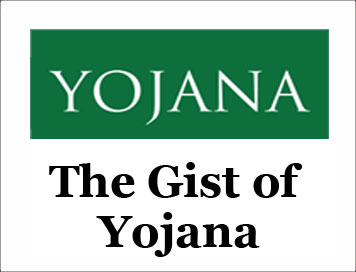(HOT) UPSC Current Affairs 2025 PDF
NEW! The Gist (NOV-2025) | E-BOOKS
(GIST OF YOJANA) Managing Risks of Disaster for Sustainable Development - March - 2017

(GIST OF YOJANA) Managing Risks of Disaster for Sustainable Development - March - 2017
Disaster management has evolved a long way from managing events of disaster to managing the risks of disasters. Risk management approach to disasters means that the underlying hazards and vulnerabilities, natural-oranthropogenic, are assessed scientifically and necessary measures are taken to prevent the creation of risks-ab initio. It also means that. existing risks are reduced through a combination of various structural and non-structural. measures including innovative mechanisms of risk sharing and risk insurance. For the residual risks that are neither prevented, nor reduced nor insured, there is no other alternative but to get prepared for disasters. Disaster preparedness means getting prepared for responding to disasters effectively as and when it strikes so that lives can be saved and human sufferings reduced to the maximum extent possible through measures like evacuation, search and rescue and humanitarian assistance like shelter and relief. Preparedness further means having policies, strategies and resources in place for 'building back better' livelihoods, houses and infrastrctures devastated during disasters.
As per an estimate of the UN office for Disaster Reduction (UNISDR) during the past two decades as many as 1.3 million people were killed, 4.4 billion people affected and 2 trillion dollars lost due to disasters.
India had its share of such damage and losses. The World Bank had estimated that the economic losses due to disasters during the late nineties and early years of this century were close to two percent of the GDP, whereas similar amount was not invested for public health in the country.
Disaster and Development
Disasters are intertwined with development in a three-dimensional nexus. First, disasters eat away hard earned gains of development of years and decades. Second, lack of development exposes vulnerable communities to the risks of disasters. Third and ironically in an opposite direction, development creates new risks of disasters, such as houses arid infrastructure without compliance of zoning and building regulations are vulnerable; mining and industries in ecologically sensitive zones may destroy the natural buffer to disasters, while fossil fuel based production and consumption enhance risks of climate related disasters.
Challenges and Opportunities
India played crucial role in the finalization of all three global agreements of 2015. Being the second largest populous country, sixth largest economy and the fastest growing major economy, India has also the largest number of people with abject poverty, children with malnutrition and adults with illiteracy in the world. Therefore India holds the key to achieving the global goals and targets of sustainable development and disaster resilience.
India has put in place legal and institutional mechanisms at various levels and deployed scientific and technological capabilities for disaster risk management with clearly visible impacts on loss of lives, as was demonstrated during some of the recent meteorological disasters like cyclones (cyclones Phailin and Hudhud). However similar results were not seen in hydrological disasters like floods or cloudbursts (Uttarakhand, Srinagar and Chennai) or geological disasters like landslides (Malin and north Sikkim). Technological disasters like industrial or road accidents continue to spiral; threats of biological disasters like epidemics and pandemics loom large, while environmental disasters like depleting water resources and' rising level of air pollution in rapidly growing urban settlements are causes of major concerns. India's capability of managing risks of earthquakes have not really been tested after the Kutch earthquake of 2001 and experts have been warning of catastrophic impacts if major earthquake strikes anywhere near thickly populated urban centres.
India has embarked on the pathway of rapid economic growth which is expected to be propelled by some of the new initiatives like Make in India, Skill India, Digital India, Swachh Bharat Abhiyan, Smart Cities Mission etc. Probably it would not at all be an exaggeration to say that during the next one and half decade public and private investments for social and economic development of India would far exceed the investments made during the past four or five decades. This provides opportunities for planning, designing and implementing the development projects in different sectors in manners that do not compound the risks but contribute to the process of mitigating the risks of disasters.
Mainstreaming disaster risk reduction into every aspect of development had been in the agenda of disaster management for quite some time, but not much headway has been achieved in this direction. Neither the National Disaster Management Authority has come up with any general or specific guidelines for mainstreaming nor the sectoral ministries and departments of the central or state governments developed concrete plans of action for building disaster resilience in their respective sectors. Implementation of the Sendai Framework in conjunction with the Sustainable Development Goals and Paris Climate Agreement provide opportunities for addressing this .hitherto neglected but challenging tasks of disaster risk management in Iridia.
Study Material for UPSC Pre General Studies (Paper-1)
This is Only Sample Material, To Get Full Materials Buy The Gist 1 Year Subscription - "Only PDF" Click Here
Click Here to Download More Free Sample Material
Go Back To Main Page
Courtesy: Yojana

